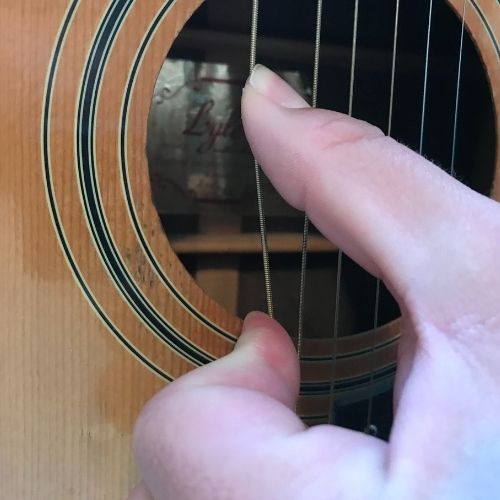We may get commissions for purchases made through links in this post. Thanks for the support! 👍
Do you want to buy a high-quality guitar? If you answered yes, you’ve come to the correct place. You must ensure that the guitar you purchase is in good condition. It is not a difficult chore for you if you have basic abilities and are up to date.
This article will guide you through the process of selecting a high-quality guitar. The methods below may assist you in selecting a high-quality guitar that meets your needs and expectations.
Before you buy, you should inspect the instrument from top to bottom. For example, frets, soundboard, and fretboard, including tuners, must all be thoroughly examined before final selection.
Generally speaking, the more expensive a guitar, the better quality the guitar will be. Once you get into the $1000+ range, you are generally more looking for the feature that you prefer, rather than looking at what kind of quality the guitar is. So this guide is for those people that are looking for guitars at less than $1000.

1. The Tuning Machines
The cost and quality of tuning equipment differ from one another. A high-quality handcrafted outfit will cost you extra. Tuning machinery (these things right here) for guitars must be checked individually by you. For testing reasons, you can turn each tuning knob one at a time.
You must also inspect the guitar’s roller at the same time. Do you see what I mean? The roller must turn without pause when you move the knob.
If this occurs, the instrument is still suitable for purchase. One full turn of the knob up and down is required to complete your evaluation.
Generally speaking, tuning knobs should all feel similar when turning, and shouldn’t take much effort at all. On used guitars, you will find that some tuning knobs may be harder to turn, this may mean they are damaged, or might just need cleaned well.
2. The Guitar Neck
After performing the tuning machine inspection, you must examine the guitar neck. You may look attentively at the guitar’s neck. Yes, the neck of the guitar must be straight, with no bends or bows. The neck region of the guitar refers to the area between the headstock and the bridge of the instrument.
The neck section has no warping or twisting concerns. If the neck is damaged with difficulties such as warping or twisting, do not purchase the instrument.
Sometimes the neck will be bent, which you may not see when purchasing the guitar. As a result, paying particular attention to the neck area is essential. A twisted neck does not qualify for purchasing.
If the guitar’s neck is bent, you will generally hear buzzing from the strings on certain frets, or certain strings in specific areas. If a guitar neck is not bent, no buzzing should happen.
3. Fretboard check
The fretboard is checked next. A smooth, level surface with no dents is a good omen for your buy. When you buy, no protrusion beyond the sides is permitted. A fretboard with well-placed frets is required for a quality guitar to purchase.
A common issue you can find on cheaper, lower-quality guitars is uneven frets (the actual metal pieces), and this can cause a buzzing sound. You will want to check and make sure they are all even.
Another issue in this department is a sharp fret end! This doesn’t affect the sound but can cut you as you play guitar. Frets are originally just wires (these are what they are before being installed) that are inserted into the grooves and then cut off, the better quality the guitar, the smoother these have been sanded down. It means more time taken to build the guitar, but is a much better experience.
4. Guitar action
A guitar’s action simply specifies how near the strings are to the fretboard. The angle at which they are positioned about the fretboard is also important for proper guitar motion.
Lower action is a wonderful choice for playing guitar smoothly. Confirm that there is no buzzing on any fret, even at low or moderate volume levels.
Now, higher or lower action is not a defining characteristic of the quality of the guitar, as this is just up to personal preference. However if the action is out of whack (you guessed it) you will hear buzzing.
5. The Intonation
When purchasing a high-quality guitar, you can expect it to have excellent intonation. How do you verify it?
Simply compare the sound of the note plucked on the 12th fret of each string to the harmonic generated on each string at the 12th fret to verify this. If there is a difference in pitch between the two, the guitar has poor intonation and should not be purchased.
6. The Soundboard
Now, let us come to the soundboard of the guitar instrument to check the quality. It should be free of cracks and so you will have to pay a close look.
7. The Body
What is the following criterion for a good guitar? You may inspect the guitar body from the back and front. This is to inspect the instruction for any cracks. Examine the guitar’s seam for any separation. If you see any cracks or separation, do not buy the guitar.
Note: You may also touch the instrument to check for loose things within. If you hear weird noises inside, such as rattling or buzzing, it is a clear indicator of a problem, such as loose materials. If you do not discover loose braces at the time of purchasing, they may cause problems.
Are cheap guitars bad?
I am someone that believes there is something for everyone in the world of guitars. If you are in need of a cheap guitar, then get a cheap guitar! You may be sacrificing some qualities that we talked about earlier in this article, but it will at least get you a guitar (like this one) you can learn to play on, and then upgrade later on.
You may even find that you will end up purchasing multiple different cheap guitars, as you figure out what features you do and don’t like. For example, some people like cutaways on their acoustic guitars, and others don’t. Some people like high actions, v-shaped necks, composite body guitars, and others don’t.
Buying a cheap guitar in the beginning and finding what you like is important, especially before you start spending large amounts of money on a long-term guitar.
Conclusion
dsThis article will assist you in selecting a high-quality guitar when you go shopping. The actions outlined above will point you in the correct direction. You may use these tips to determine whether or not a guitar is of high quality.
Make certain that the guitar you choose is played to your complete satisfaction. Indeed, this post is well researched to give you awesome results. All the best for your selection.


